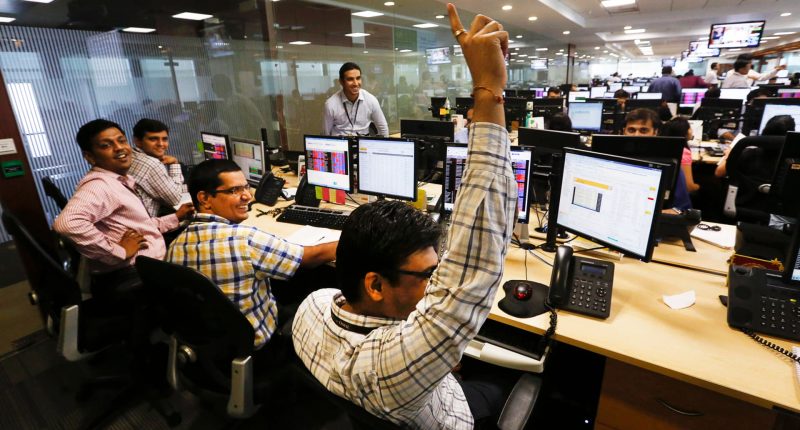Share this @internewscast.com
India traders at the Motilal Oswal Financial Services Ltd. office in Mumbai, India.
Vivek Prakash | Bloomberg | Getty Images
This report is from this week’s CNBC’s “Inside India” newsletter which brings you timely, insightful news and market commentary on the emerging powerhouse and the big businesses behind its meteoric rise. Like what you see? You can subscribe here.
The big story
India’s stock market seems to have gotten back its mojo.
While the Nifty 50 index remains more than 7% below its all-time high reached on September 26, it has rallied about 10% since bottoming out on April 7, when trade tensions between the United States and China escalated.
While concerns over the state of the global economy soured risk sentiment around the world, the slide in Indian equities began long before Donald Trump began his second mandate as U.S. president and trade tariffs dominated news headlines.
Much of the pain for investors, though, has come from within. Valuations for stocks had risen while earnings flatlined, or worse, were deteriorating. At their peak, Indian large-cap stocks in the iShares MSCI India ETF were being valued at nearly 30 times the earnings, significantly higher than their five-year average.
However, the strong rally over the past two weeks raises the question of whether stocks have found a floor, and if investors are now looking past the short-term volatility.
A key factor underpinning the market’s resilience has been the unwavering support from domestic investors pushing funds into stocks through their systematic investment plans (SIPs), which has offset withdrawals from foreign investors.
Despite foreign portfolio investors (FPIs) pulling significant capital out earlier in the year, local institutions have stepped in, according to analysts at ICICI Securities.
Vinod Karki, equity strategist at the bank, pointed out that domestic institutional investors (DIIs) have so far poured in $3 billion in April, only marginally lower than the $3.2 billion in foreign fund outflows amid the trade war volatility.
“Stock reaction during April’25 so far indicates that DIIs may have continued buying domestic-driven stocks (financials, industrials and consumption) while stocks related to global demand may have seen selling,” Karki said. “Cash positions of active funds have risen further while SIP inflows were stable during Mar’25 – bodes well for market stability, assuming FPI selling intensifies.”
JPMorgan analysts echoed this sentiment in a note on HDFC Asset Management, one of the largest fund houses in the country.
“The industry maintained positive new equity flows despite negative market movements in 4Q, demonstrating stability in domestic flows primarily driven by SIP contributions,” said the Wall Street bank’s analysts led by Harsh Wardhan Modi. India’s fiscal year runs from April through March.
Beyond flows, signs of improvement are emerging in specific sectors.
ICICI Securities research also pointed to profitability “bottoming out” for companies in the mining and chemicals sector and to “fewer EPS downgrades” expected from analysts. CNBC Inside India’s analysis reveals that analysts have steadily lowered their 2025 earnings per share expectations for Indian stocks by 10% over the past two years, setting up investors for a profitable surprise when companies beat estimates.
On the geopolitical front, some analysts also hold the current global trade tensions, while serious, may offer more potential for resolution than did previous crises.
ICICI’s Karki said the current crisis could be fixed by politicians, unlike the global financial crisis or the pandemic, adding that “human interventions to avert a major global crisis” are still possible.
Others agree.
“Broadly, our stance on India being unfazed by the trade war stays, and we believe it will be ‘relatively unfazed’ in the short run while it could emerge as a beneficiary in the longer run if a trade deal materializes,” said Bernstein’s equity strategist Venugopal Garre in a note to clients.
Despite the domestic optimism, significant hurdles remain, preventing the appearance of an ‘all-clear’ signal. The primary concern, echoed by multiple analysts, is the impact of the “global tariff war.”
Goldman Sachs said that the “investment activity is likely to remain subdued owing to the US ‘reciprocal’ tariff-related policy uncertainties.”
India’s crucial IT sector, heavily reliant on Western markets, is likely to take a direct hit from such headwinds. IT outsourcing giants Wipro, Infosys, and HCL Technologies have consistently flagged weak guidance and heightened uncertainty impacting client spending.
A JPMorgan analyst called HCL’s performance a “rare feat” for simply being in-line — underscoring the challenging environment for the sector overall.
However, as the green shoots for the market appear to be growing in the shadow of the trade war, the risks remain tangible.
Need to know
Indian Prime Minister Narendra Modi met U.S. Vice President JD Vance on Monday. In a statement from Modi’s office, both leaders expressed “significant progress” in their discussions on bilateral trade and cooperation in areas such as energy and defense. Vance, who was in India on a mostly personal trip with second lady Usha Vance and his family, met Modi in New Delhi.
Progress in India-U.S. trade deal. Indian Finance Minister Nirmala Sitharaman expressed hope that an India-U.S. bilateral agreement on trade could be reached “by the fall this year,” according to comments made in San Francisco on Monday. The negotiations, which commenced Wednesday and conclude Friday, will be led by the country’s new chief trade negotiator Rajesh Agrawal. Sitharaman also said New Delhi is aiming to lower the country’s fiscal deficit below 4.5% of gross domestic product by financial year 2026 from 4.8% currently.
Tesla is preparing to enter the Indian market. Speaking on an earnings call, CFO Vaibhav Taneja confirmed reports that the company is working on an expansion into India, adding that it would be a great market to enter, thanks to its “big middle class.” Nevertheless, India is also “a very hard market,” with EV imports into the country subject to a 70% tariff and about 30% luxury tax, he said, noting that this could make India-sold Tesla’s twice as expensive.
What happened in the markets?
Indian stocks have continued their run up this week. The Nifty 50 index closed above 24,000 points for the first time since the end of January this year, heading for a 1.7% gain this week. The index turned positive and has risen 2.54% this year.
The benchmark 10-year Indian government bond yield have continued to fall and are down to 6.3% this week.

On CNBC TV this week, Hiren Dasani, co-head of emerging markets equity at Goldman Sachs Asset Management, said India’s domestic fundamentals are improving and economic growth appears to have bottomed out, making India a diversification play amid the broader market uncertainty. The Indian market is “one of the only few markets” that is up since U.S. President Donald Trump unleashed his “reciprocal” tariffs on April 2, Dasani observed.
Meanwhile, Ruchit Mehta, head of research at SBI Mutual Fund, highlighted India’s “fair solid domestic growth story,” which he said is supported by strong consumption trends and by its advantage as a net importer amid global trade uncertainties. Mehta is also optimistic on the country’s banking sector.
What’s happening next week?
The Indian initial public offering drought has some reprieve in the form of Tankup Engineers, a SME manufacturer of fuel storage solutions, listing on Wednesday. However, mainline IPOs have yet to make a comeback in India.
April 25: U.S. Michigan Consumer Sentiment for April, Japan’s Tokyo consumer price index for April
April 28: India industrial and manufacturing production for March
April 30: Tankup Engineers IPO, U.S. personal consumptions expenditure index for March, flash GDP reading for Q1, euro zone flash GDP for Q1
May 1: Bank of Japan interest rate decision, U.S. ISM manufacturing PMI for April








